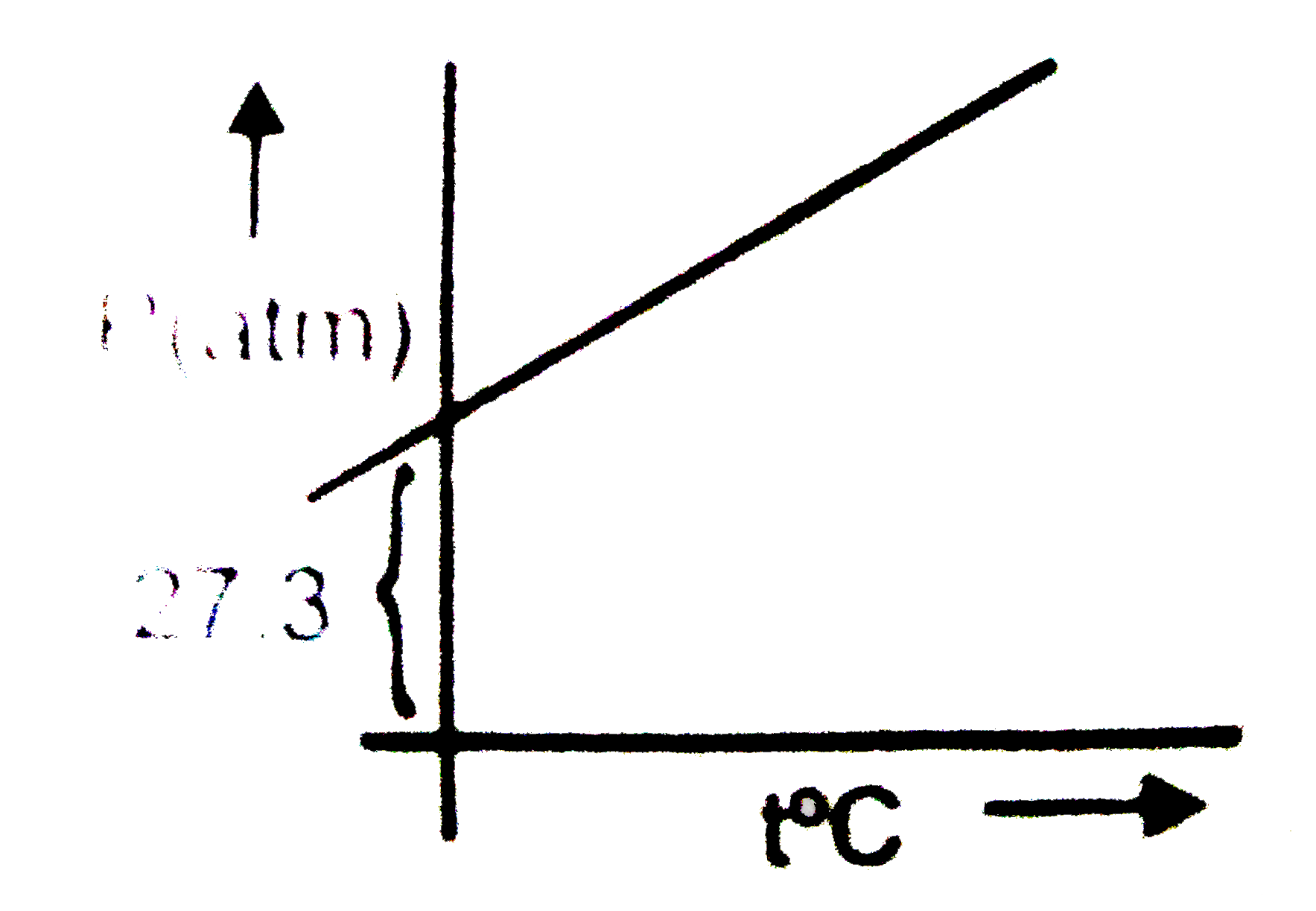A graph is plotted for a vanderwaal's gas between PVm vs P leading to an intercept of 22.16 litre-atm. The temperature of gas at which these observations of P and Vm were made is ___________ ∘C
(R=0.08 litre atmK−1mol−1)
The correct Answer is:4
To solve the problem, we need to determine the temperature of a Van der Waals gas from the given intercept of the graph plotted between PVm (pressure multiplied by molar volume) and P (pressure). The intercept is given as 22.16 liter-atm, and the gas constant R is 0.08 liter-atm K−1 mol−1.
1. Understand the Van der Waals Equation:
The Van der Waals equation for one mole of gas can be written as:
(P+aV2m)(Vm−b)=RT
where a and b are Van der Waals constants.
2. Simplify for High Pressure:
At high pressure, the term aV2m becomes negligible, and we can simplify the equation to:
P(Vm−b)=RT
Rearranging gives:
PVm−Pb=RT
or
PVm=Pb+RT
3. Identify the Intercept:
From the equation PVm=Pb+RT, we can see that if we plot PVm against P, the y-intercept (when P=0) is equal to RT.
4. Set Up the Equation:
Given that the intercept is 22.16 liter-atm, we can write:
RT=22.16
5. Substitute the Value of R:
We know R=0.08 liter-atm K−1 mol−1. Substituting this into the equation gives:
0.08T=22.16
6. Solve for Temperature (T):
To find T, we rearrange the equation:
T=22.160.08
Calculating this gives:
T=277 K
7. Convert Temperature to Celsius:
To convert from Kelvin to Celsius, we use the formula:
T(°C)=T(K)−273
Thus,
T(°C)=277−273=4°C
Final Answer:
The temperature of the gas at which these observations were made is 4 °C.
The Van der Waals equation for one mole of gas can be written as:
(P+aV2m)(Vm−b)=RT
where a and b are Van der Waals constants.
At high pressure, the term aV2m becomes negligible, and we can simplify the equation to:
P(Vm−b)=RT
Rearranging gives:
PVm−Pb=RT
or
PVm=Pb+RT
From the equation PVm=Pb+RT, we can see that if we plot PVm against P, the y-intercept (when P=0) is equal to RT.
Given that the intercept is 22.16 liter-atm, we can write:
RT=22.16
We know R=0.08 liter-atm K−1 mol−1. Substituting this into the equation gives:
0.08T=22.16
To find T, we rearrange the equation:
T=22.160.08
Calculating this gives:
T=277 K
To convert from Kelvin to Celsius, we use the formula:
T(°C)=T(K)−273
Thus,
T(°C)=277−273=4°C
The temperature of the gas at which these observations were made is 4 °C.
Topper's Solved these Questions
- STATES OF MATTERBOOK - VMC MODULES ENGLISHCHAPTER - STATES OF MATTEREXERCISE - JEE-Main ( ARCHIVE )
17 Videos
- STATES OF MATTERBOOK - VMC MODULES ENGLISHCHAPTER - STATES OF MATTEREXERCISE - JEE-Advanced
78 Videos
- STATES OF MATTERBOOK - VMC MODULES ENGLISHCHAPTER - STATES OF MATTEREXERCISE - Level-2
50 Videos
- STATES OF MATTERBOOK - VMC MODULES ENGLISHCHAPTER - STATES OF MATTEREXERCISE - IMPECCABLE
50 Videos
- STOICHIOMETRY - IBOOK - VMC MODULES ENGLISHCHAPTER - STOICHIOMETRY - IEXERCISE - JEE Advanced (Archive)
31 Videos
Similar Questions
A graph is plotted between PVm along y-axis and P along x-axis, where Vm is the molar volume of a real gas. Find the intercept .
View Solution10 g of a gas at 1 atm and 273 K occupies 5 litres. The temperature at which the volume becomes double for the same mass of gas at the same pressure is:
View SolutionWhat is the density of N2 gas at 227∘Cand5.00atm pressure? (R=0.0821atmK−1mol−1)
View SolutionA graph is plotted between PVm along Y-axis and P along X-axis whre Vm is the molar volume of a real gas Find the intercept along Y-axis .
View SolutionThe weight of CH4 in a 9L cylinder at 27∘C temperature and 16 atm pressure is (R = 0.08 L atm K−1mol−1 )
View SolutionAt 27∘C it was observed in the hydrogenation of a reaction, the pressure of H2(g) decreases form 10atm to 2atm in 10min. Calculate the rate of reaction in M−1min (Given R=0.08LatmK−1mol−1)
View SolutionA graph is plotted between p (atm) vs t∘C for 10 mol of an ideal gas as follows:
Then slope of curve and volume of container (L) respectively, are:

View SolutionUnder what conditions will a pure sample of an ideal gas not only exhibit a pressure of 1atm but also a concentration of 1mollitre−1
[R=0.082 iltre atm mol−1K−1]
View SolutionAt 27∘C it was observed during a reaction of hydogenation, that the pressure of hydrogen gas decreasses from 2 atm to 1.1 atm in 75 min. Calculate the rate of reaction (molarity s−1) (R = 0.0821 litre atm mol−1K−1)
View SolutionThe density of O2 gas at 127o C and 4.0 atm pressure is (R = 0.082 L atm K−1 mol−1)
View Solution
